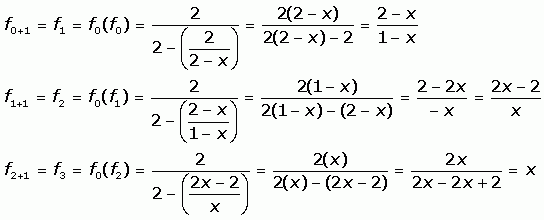 |
 |
|
Question from RJ, a high school teacher: My son asked me this question and I am not sure about it so if you could help me solve it I would greatly appreciate it. The question is : Let f0(x) = 2/2-x and fn+1 = f0 o fn for n greater than or equal to 0. Find a formula for |
|
Hi RJ. Whenever you are trying to come up with a formula or whenever starting out a mathematical induction proof, it is worthwhile to try the first few values of n to see what is happening. So starting with the function definition:
Let's look at the first few values of fn (x):
So this function cycles. The proof is almost done already, so I'll leave the rest to you. Stephen La Rocque.> RJ wrote back
What Sue did was to show that
From here it follows that
and the pattern repeats. The essence of the induction argument is to be more formal with the clause the pattern repeats. I am going to change the indexing so that it starts at 1 rather than 0. Let gn = fn-1for n = 1, 2, ... For each n there are integers k and i with i = 1, 2, 3 or 4 so that n = 4k + i. The pattern I see and want to prove is that for each k
I am going to prove this using induction on k. Sue proved this for k = 0. This is the first step in the induction argument. I want to show that the pattern repeats. To do this I assume that I have proved this for some particular value of k and I want to verify it is true for the next value of k. So I am assuming the 4 equations above are true for some particular value of k but not necessarily for any larger k. Using the definition in the problem
In a similar fashion you can show that
Hence the pattern does hold for k+1. Thus, by induction the formula I found for fn is valid for all n = 0, 1, 2, ... Penny |
 |
 |
 |

